► CAR lives with an i-Pace
► Editor-in-chief Phil Mc is your guide
► Can the e-Jag settle into daily life?
Month 8 of our Jaguar i-Pace long-term test: the conclusion
Many years ago, a Ford PR man told me – approvingly – that I didn’t have any small talk. But ever since I joined the one per cent, I can fill all kinds of conversational vacuums. Not that one per cent, the single-digit (but rapidly growing) club of UK motorists who buy a new electric car. Getting the i-Pace was not just a test of a new car, but of a new lifestyle. And discourse.
Conversation topic #1 is ‘How far does it go?’ – range and charging anxiety are uppermost in the human psyche. The i-Pace is officially rated at between 258 and 292 miles, depending on spec. But fully charged, our luxuriously equipped car didn’t display a range north of 225 miles under my keeping.
Its longest stint was 191 miles to deepest Cornwall using Eco mode: as you can read in our Month 7 update below, I never pushed my luck further.
Then you get ‘How hard is it to charge?’ and detailing the merits of 7kW chargers vs 50kW chargers vs 100kW+ ultrarapid chargers may not make for chat nirvana. The unvarnished truth is that too many chargers are inoperable for various reasons, so your well-laid plan needs a fallback position, and quaffing 50kW for an hour-plus only gives about 100 i-Pace miles. The UK needs more – and far faster – chargers. To support a 100 per cent electric new-car market, car industry body the SMMT calculates we’ll need to go from 19,000 to 2.8 million chargers by 2035. At a cost of £16.7 billion. Gulp.
But most EV early adopters will only need to juice up on that occasional long journey or staycation, and the odd hour or two of stopovers is tolerable. If you have off-road parking at home or chargers at work, running an EV should slip neatly into your life. My middle-class circle nods agreeably when I hector that every household’s second car should be electric. But they’ll need a wallbox: my 7kW BP Chargemaster unit install cost £449, thanks to a £500 government subsidy that’s now been reduced to £350.
The related question is typically ‘How much does it cost to run?’ On a cheap overnight tariff, an i-Pace charge totalled £8, so about £20 for 500 miles. A punchy twin-turbodiesel F-Pace, though still down 100bhp and a couple of seconds to 62mph on the electric Jag, would need around £78 to gas for 500 miles. And there is an undoubted feelgood factor from emitting zero pollutants on the go.
Of course you need to factor in EVs’ higher acquisition prices, especially when £17k of options makes for an £80,000 i-Pace. Although memory seats were handy because my wife is half my size, I never used the front-seat cooling and the rear heaters were buried under child seats – bank that £4k. I’d also forego the £900 head-up display, £400 auto-dimming door mirrors (really?) and the £1650 adaptive headlamps.

But I’m a sucker for a glass roof (£960), and this i-Pace looks sensational (even when dirty) in £700 Caesium Blue paint, with £260 black trim flourishes and pricey 22-inch alloys (£2900). The low-profile rubber doesn’t compromise the air of civility or composed ride on £1100 air springs. The optional towbar proved useful, too (see Tim Pollard lugging bicycle racks, above).
I used the £500 camera pack to monitor my parking position, and utilised the stop and go cruise control, part of a £1350 pack with blind-spot monitoring and high-speed emergency braking.
In hindsight, nine grand of these options were superfluous; better to just buy an S model and spec decent wheels, because the standard i-Pace is a tremendous and suitably equipped car.
Not once did the banter turn to ‘How does it feel pushing on down the B660?’ but I’d rhapsodise nonetheless. The dual-motor i-Pace launches like a cannonball, steers with a ballerina’s deftness, and grips like Loctite – thank those low-set battery cells between the wheels. Everyone who took a turn – from EV sceptic Ben Miller to my wife – was smitten by the way it drives. Personally I’d like more aggressive regenerative deceleration to dovetail with my late-braking style, but the way the nose turns in once you lift is the gift that keeps on giving.
And the i-Pace does all it’s asked: a deep boot stows pram, scooters or luggage, the rear seats fold not-quite-flat but still handle recycling runs. With its instant performance, air of calm, vast cabin space and low running costs, it’s a great electric car. Actually, it’s just a brilliant car full stop.
So that leads to question #5: ‘Would you have another electric car?’ This lifestyle is not for the inflexible, disorganised or shy. But I’d definitely have another EV. Whether it’ll be as great as the Jag is another conversation entirely.
By Phil McNamara
Logbook: Jaguar i-Pace S
Price £64,995 (£80,980 as tested)
Performance 90kWh battery, twin e-motors, 395bhp, 4.8sec 0-62mph, 124mph
Efficiency 2.5 miles per kWh (official), 2.4 miles per kWh (tested)
Energy cost 4.6p per mile
Miles this month 1036
Total miles 13,126
Count the cost: Jaguar i-Pace depreciation
Cost new £80,980
Part exchange £51,660
Cost per mile 4.6p
Cost per mile including depreciation £2.69
Month 7 living with the Jag i-Pace: the anatomy of a long journey in an electric car
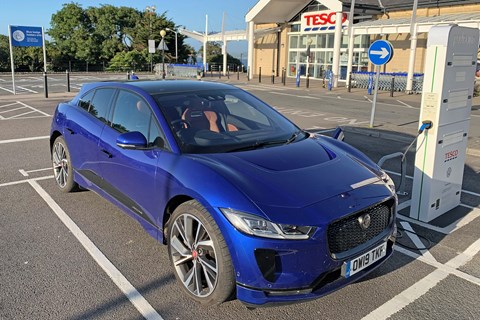
1. Range anxiety? It's charging anxiety
As pioneering goes, driving from Hertfordshire to Cornwall in an electric car does not equate to Cortés discovering California. But jeopardy still exists, as the Nissan Leaf stranded on the M5 a few miles from Exeter services' chargers demonstrates. During my family's 684-mile, week-long odyssey, there were five episodes where we couldn't get a charger to work, or found it in use, raising the prospect of a two-hour pitstop. Considering we only tried to charge nine times, that's a majority of hassle.
2. The iPace absolutely can do staycations
The best certified iPace range is 292 miles: well-equipped, big-wheeled OW19 TKF offers 220 when 'brimmed'. On this trip, I fastidiously used Eco mode, optimising the air-con and my right foot with a real-time consumption coach. Take it easy – a doddle when averaging 57mph on the A303, with bonus rollercoaster descents to recoup energy – and you can see a 1:1 ratio between miles travelled and decreasing range. We eked 200 miles from the Jaguar, despite stuffing it with five people and luggage.
3. There are chargers, and there are chargers
For long EV journeys, abide by the three Ps: planning, pliability and patience. Plan where to stop, have a fallback position or two, and be happy to wait. St Ives' only chargers were four gratis 7kW Pod Points at Tesco: thank heavens for no parking time restriction, because we needed to charge overnight. A 50kW charger is deemed rapid, but still takes over an hour to get 100 miles of range. We did manage a one-stop strategy coming home, thanks to the 125kW Instavolt chargers at the Route 303 diner near Honiton. One hour, £19.63 and 150 miles banked: yes!
4. i-Bloomin' lovely to drive
Regular readers will know we love the i-Pace dynamically. This trip felt no different: thrilling launches past dawdling cars on Salisbury Plain, that monumental steering scything through A303 roundabouts, unrelenting front-end grip. The calm motorway refinement and cushy, air-suspended ride was a boon too.
5. The numbers add up
Holidaying by EV presents some challenges, none insurmountable. And there's another benefit to consider: doing those miles in the most economical F-Pace diesel would cost a minimum of 12.3p a mile; in the i-Pace it was 7.3p for this trip. So when you've got the sand out of your shoes and the tan has faded, you can reflect on a few quid saved, and zero tailpipe emissions.
By Phil McNamara
Logbook: Jaguar i-Pace S
Price £64,995 (£80,980 as tested)
Performance 90kWh battery, two e-motors, 395bhp, 4.8sec 0-62mph, 124mph
Efficiency 2.5 miles per kWh (official), 2.6 miles per kWh (tested), 0g/km CO2
Energy cost 6.0p per mile
Miles this month 924
Total miles 12,090
Month 6 living with a Jaguar i-Pace: appy thoughts
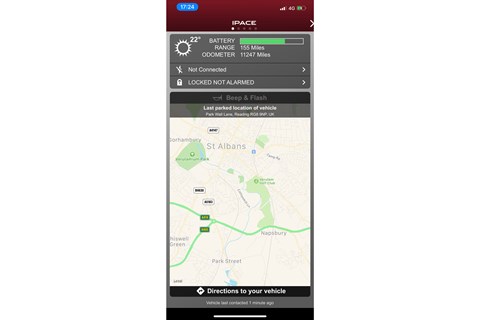
My previous encounter with Jaguar's InControl Remote app was when I ran an XF Sportbrake and found that the app was the only way to reliably connect my iPhone to the car. Such niggles are history – the iPace offers Apple CarPlay as part of its hugely improved Touch Pro Duo control interface.
To access InControl Remote, once you've registered your Jag on the website, you sit in your car and press the Optimised Assistance button in the overhead panel. This connects all the telematics, opening up all kinds of functionality in the smartphone app, gratis for the first year.
I no longer have to blunder around in the dark to assess range and therefore charging imperative – just glance at the app. Cooling or warming the car remotely is also possible. And I can do all that routine stuff of locking it remotely, and beeping the horn and flashing the lights to locate the car, though the neighbours seem to find this feature less essential than I.
Finally, you can opt in to log the consumption of each journey, mostly trips to my daughter's nursery or the supermarket just now. Time for an efficiency competition with my wife, in a bid to ameliorate her maximum-attack driving style? Soberingly, she's getting almost a mile more per kWh than I.
By Phil McNamara
Logbook: Jaguar i-Pace S
Price £64,995 (£80,980 as tested)
Performance 90kWh battery, two e-motors, 395bhp, 4.8sec 0-62mph, 124mph
Efficiency 2.5 miles per kWh (official), 2.2 miles per kWh (tested), 0g/km CO2
Energy cost 4.3p per mile
Miles this month 729
Total miles 11,166
Month 5 living with a Jaguar i-Pace: just enjoy it
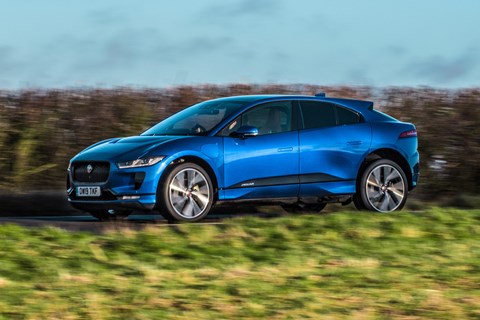
There's 13 miles to St Albans, I've got a fully charged battery, half a packet of Polo mints, it's dark out and so on. This is a rare chance to drive the i-Pace without worrying about battery preservation.
The roads out of Edgware after midnight are empty and national speed limit, so I accelerate hard. The Jag spins out 516lb ft of torque but it feels much punchier. The 0-62mph sprint takes less than 5.0sec – not quite hypercar-quick, but hypercars don't seat five or emit zero tailpipe pollution.
The i-Pace's dynamic prowess is even more notable: through some fast sweepers, it feels like there's a giant, invisible hand on the roof, pressing the EV into the road, keeping the body level and the tyres stuck fast. But my favourite aspect of the electric Jag is the steering. The rack feels pretty heavy but the response is anything but leaden, turning in eagerly and positively.
It's not just me. Editor Ben Miller, an EV sceptic, said this after borrowing the Jag for a weekend: 'It handles beautifully. The way the i-Pace controls its weight and attitude as you turn is incredible. Love that the regenerative braking effectively makes you a left-foot-braking master, your easing of the throttle enough to transfer weight onto the nose and help it do your bidding understeer-free.' Editor-at-large Chris Chilton says it's his favourite current Jag by far.
All of this got me thinking: I wonder what Jaguar's chief engineer Mike Cross makes of his handiwork a couple of years on? So we had a video call to discuss it.
'I wanted the i-Pace to be a Jaguar first and foremost, just one that happened to have a different powertrain,' says the head of vehicle integrity, whose team set the dynamic parameters for every Jag and Land Rover. 'So we focused on steering, ride, handling, NVH (noise, vibration, harshness) – all the things that make a Jaguar.
'I think the steering is the most important attribute of any car. It's the one thing you use all the time. Even if you're not a driving enthusiast, good steering imbues you with confidence. We worked hard at making the steering feel good, linear and intuitive.'
Was the battery weight a problem? 'Apart from low-speed ride, there aren't any circumstances where weight would be a positive. But in the i-Pace the mass is well located because it's low down and between the wheels, and it's got motors at each end. The weight distribution is 50:50, which helped. As did four-wheel drive. You only really notice the mass when you decelerate.'
So is the i-Pace Mike's finest hour? 'It's always about the next car,' he replies. 'I've been fortunate to have worked on the i-Pace and the new Defender, both of which are very significant cars. But of all the cars I've done, the [2009] XFR is probably still my favourite actually.
'It was fast, effortless, refined, fun to drive – everything a Jaguar should be.' And that ethos still guides Jaguar – as everyone who drives the i-Pace seems to agree.
By Phil McNamara
Logbook: Jaguar i-Pace S
Price £64,995 (£80,980 as tested)
Performance 90kWh battery, two e-motors, 395bhp, 4.8sec 0-62mph, 124mph
Efficiency 2.5 miles per kWh (official), 2.2 miles per kWh (tested), 0g/km CO2
Energy cost 5.5p per mile
Miles this month 293
Total miles 10,730
Month 4 living with a Jaguar i-Pace: car-like proportions? Not here...
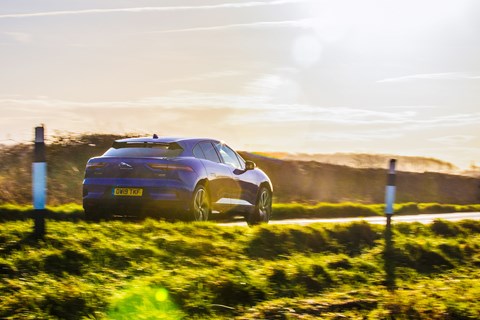
I love gazing out the window at the i-Pace. Stubby nose like a mid-engined supercar's, hatchback rump, a wheelbase the length of an Audi A8 limo's (but overall 453mm shorter), SUV-sized wheels and a roofline that sits midway between saloon and SUV.
Jag's designers reallocated the space no longer required for combustion-engine gubbins to the passenger cell. Audi e-Tron take note. Rear passengers get copious legroom, and the wide footwell allows my kids to walk across to their child seats. The 577-litre boot is pretty big too, but it's deep rather than tall. Still, the other day it swallowed two small bikes and a scooter, plus a back-up pram.
By Phil McNamara
Logbook: Jaguar i-Pace S
Price £64,995 (£80,980 as tested)
Performance 90kWh battery, two e-motors, 395bhp, 4.8sec 0-62mph, 124mph
Efficiency 2.5 miles per kWh (official), 2.1 miles per kWh (tested), 0g/km CO2
Energy cost 5.0p per mile
Miles this month 593
Total miles 10,437
Month 3 living with a Jaguar i-Pace: another wallbox convert
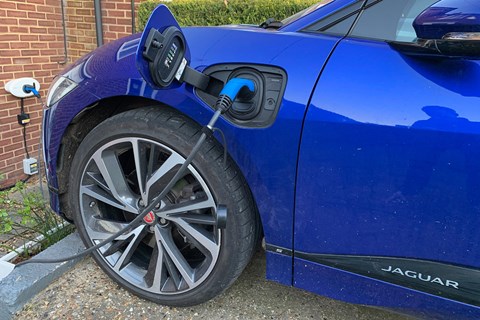
Hallelujah! My days of arriving at the office chilled to the marrow from a heater-free commute, nerves shredded by range anxiety (closest shave: eight miles and four per cent charge remaining) are over. Today, BP Chargemaster fits my 7kW ‘socketed’ smart home charger!
It’s taken about a month to get to Installation Day, because BP has to assess the suitability of your property, veracity of your claim to own an electrified car, and complete some paperwork to unlock the government’s £500 subsidy. Typically this is done by the applicant sending photos of their home fuse board and its location plus the point to install the charger, and sharing their car’s V5c document and household electricity Meter Point Administration Number (find it on your electricity bill, if you’re feeling MPAN curious!).
Though largely common-sense, this is a task that differs at every property, so Chargemaster is trialling a concierge home visit service. This did not go exactly to plan, largely because I was laid up in bed with an illness and felt somewhat aggrieved to be repeatedly bothered by a smartly dressed couple knocking on my door, presumably to enrol me in a religious organisation.
After a few choice words suggesting other households might be more amenable, I was delighted to have my misconception challenged and welcomed in BP Chargemaster’s technical and home charging experts Andrew Stead and Elaine Butler.
Other big learnings were that my electricity supplier would have to fit an isolation switch to neutralise the circuit during the install, and that it would be a real squeeze to get the home charger’s circuit breaker into my fuse locker. The team also scoped out my appetite for heavy-duty electrical items, such as a hot tub, underfloor heating or a shed of power tools for dismembering Jehovah’s Witnesses. With the answer ‘none of the above’, BP were satisfied my single-phase power supply would be sufficient, and checked the smart charger’s SIM card would have sufficient signal connectivity.
One month and one isolation switch later, BP Chargemaster engineer Colin Fountain is parking his Transit Connect on my drive. The installation is incredibly thorough, effectively including a survey of your household’s electrics to check the wiring is sound and the system is safely earthed. Fountain reveals the biggest stumbling block is typically the wiring between fuseboard and charger – if the two are far apart, the cabling can cost extra and be impossible to hide from snaking alongside skirting boards or coving. No such problems in my house, so the ex-renewable electricity engineer drills through the wall, hammers in an earthing rod and wires up the charger.
It’s serious stuff, with a chunky cable externally and no room to hide the circuit breaker inside, and five hours of work. All that’s to be expected, though, given the i-Pace will be more power hungry than this year’s Democratic National Convention. Finally the work is done and Fountain talks me through how to use it. I connect the Jag to the home charger, and both parties glow green at their first union. It costs £449 after the subsidy – and worth every penny.
By Phil McNamara
Logbook: Jaguar i-Pace S
Price £64,995 (£80,980 as tested)
Performance 90kWh battery, two e-motors, 395bhp, 4.8sec 0-62mph, 124mph
Efficiency 2.5 miles per kWh (official), 2.1 miles per kWh (tested), 0g/km CO2
Energy cost 5.0p per mile
Miles this month 1527
Total miles 9824
Month 2 living with a Jaguar i-Pace: unplugged
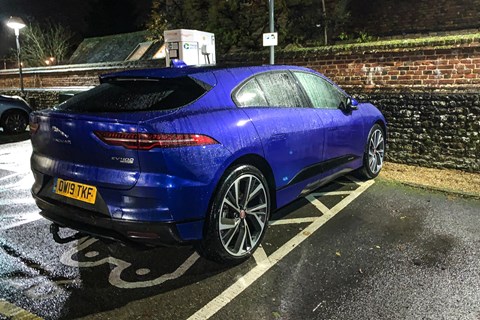
Life with an electric car and without a home wallbox requires compromises. Here's the workday routine: draw 7kW of charge for nine hours at the office, insufficient time to fully replenish the i-Pace's 90kWh battery. And in wintry weather, every 65-mile commute drains 90-odd miles. So after every trip and top-up, I start with less charge than yesterday. So I cut back on fripperies, such as driving at the speed limit. Or heating. Range anxiety infiltrates my chilling commutes, eyes flicking between predicted range and mileage to destination. I'd bite my nails, but I daren't take off my gloves.
My home bodge is to stick it on the mains for around eight hours, which generates 20 miles. Thankfully my wallbox will be fitted in a few days – but not before my longest odyssey yet, from St Albans to Goodwood.
This requires planning, and after scouring Zap-Map for chargers, I head for Midhurst's South Downs Centre. It's dark and teeming with rain when I arrive with 70 miles left and anxiety about whether it'll be available: YEEEESSSS! But the charger blurb says present your Radio-Frequency ID card to use the charger: NOOOOOO! Zap-Map advises it worked with the Charge Your Car app, so I open that, log a bank card and click 'start charge'. The 50kW DC charger starts... then stops! Repeating the process fires up the charger, and 64 minutes of Costa coffee later, I've got £14 of electricity in the cells and about 180 miles of range.
Giddily, I rag the i-Pace the rest of the way: opening up the e-afterburners to pass a ponderous Corsa and the number 60 bus, scything through the sweepers in the damp darkness. The body bobs gently on the air suspension, feeling locked and loaded but never uncomfortable. Then it's the left fork onto the Goodwood estate.
Having the i-Pace in max regen is good for drives like this. Every lift and the nose tucks in and grips as the Jag harvests energy, and fabulously weighted steering: what a front end! I arrive at the Goodwood Hotel – with sufficient range to get home tomorrow. Bliss.
By Phil McNamara
Logbook: Jaguar i-Pace S
Price £64,995 (£80,980 as tested)
Performance 90kWh battery, two e-motors, 395bhp, 4.8sec 0-62mph, 124mph
Efficiency 2.5 miles per kWh (official), 2.1 miles per kWh (tested), 0g/km CO2
Energy cost 5.0p per mile
Miles this month 1522
Total miles 8297
Diary update: towing bicycles with our Jaguar i-Pace
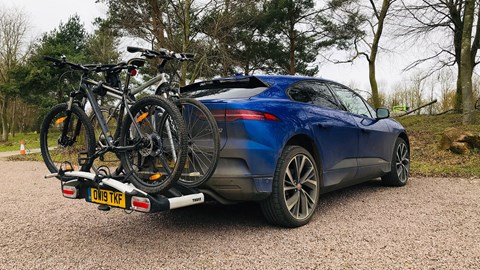
Borrowed editor-in-chief Phil McNamara's i-Pace for a weekend away (pre-lockdown, before I get told off!) and got the chance to test its family creds by ferrying children and bicycles around.
There's good news here: ours has Jaguar's own electrically retractable towbar fitted, which stows away hidden in the rear bumper when not needed. But at the touch of a button in the boot, it swings down into position, ready to tow. My Thule bike carrier plugs straight into the 13-pin electrics and all the lights and indicators sync seamlessly with the Jag's electrics. Job done.
It felt no different to drive and is proof - were it needed - that you can do normal everyday stuff with electric cars. It felt even more appropriate to arrive at Rutland Water (pictured above) in a saintly EV for our zero-emissions bike ride.
I'm planning some longer trips in the Jag i-Pace, so will report back on battery range soon. On this short local trip, the addition of a bike carrier had no meaningful impact on the electric range.
By Tim Pollard
Month 1 of our Jaguar i-Pace long-term test: the introduction
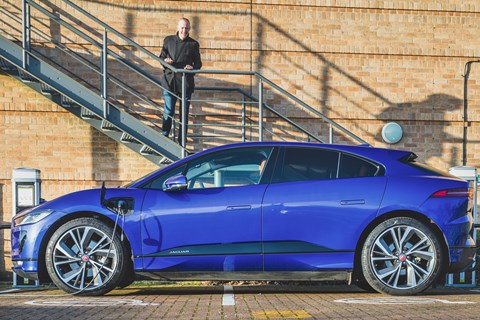
So this is it: my immersion into full electric motoring starts here, with this Jaguar i-Pace. No armbands, just in at the deep end. Or shall we liken that to my house, 65 miles from the office, and currently devoid of wallbox. The shallow end is CAR HQ, with a row of 10 restorative chargers, and a mere smattering of plug-in hybrids and full EVs to suckle on them.
To make matters a little more interesting as I make my inaugural walk to the Caesium Blue hatchback, I can see a cloud of my breath forming. This experiment will span winter's toughest months – how will that impact the 292-mile maximum range of the lightest i-Pace? The blue is the best i-Pace colour, as vibrant and eye-catching as Photon Red, but classier. Both are £700 options.
Darkness has fallen but the monolithic 22-inch rims shimmer, their split V-shaped design reminding me of vultures in flight. Costly at £2900, but i-Paces on the standard 18s look severely under-wheeled. I'll probably spend the same again on alloy repairs given the slender rubber.
Open the door and the Jaguar leaper dances on the central digital screen, while the digital instrument binnacle announces its fully charged range, my very own Oscars' Best Picture moment of suspense. The number of the beast is 259 miles. That's pretty much the quoted range for the heaviest, most luxurious i-Pace – of which OW19 TKF is a kindred spirit.
The i-Pace's base price is £64,4995 (though the government's plug-in car grant will chop £3000 off that), but this example has a whopping £16k of options. I drop into the costliest one, the 14-way adjustable heated and cooled Performance seats. Finished in tan leather, they're a beautiful shape, curved around the shoulders, slender in depth and unyieldingly firm.
Press start, then D and off the i-Pace glides, with that understated, ascending electric car whine. Swing the wheel and the brilliance of the electric Jag's steering comes flooding back. Meaty but not onerous, direct but not flighty, it makes every corner a delight. Turn-in can be enhanced by the standard all-wheel drive system, with torque vectoring to manage the torque flow at each corner – sometimes you feel the outer wheel spooling up to push the nose in.
The binnacle states 2˚C, and I get my first pang of range anxiety. Not that I fear I won't get home, but because I'd like to get back again tomorrow. I put the air-con on auto, but eschew the rear screen demister. I accept the 90kWh battery pack will take some warming, but get a shock when 13 miles of range vanish upon leaving the car park.
The ride is pretty comfortable considering we're rolling on elegant tractor wheels. Sure it feels more tense than my outgoing Citroën C5 Aircross's, bucking more noticeably over expansion joints but it's not abrupt. There are electronically controlled air springs at each corner, an £1100 option.
The £900 head-up display glows in the windscreen, while amber light streaks are visible overhead through the £960 glass roof. When traffic occasionally thins, the automated matrix LED lights go up a gear in intensity – the jury's out on whether that's £1850 well spent.
I swipe left on the central screen, to access the EV menu. Tap the brake discs icon and you can switch from mild to max regeneration when you lift: it's reassuringly aggressive, which I hope translates into prodigious battery TLC.
Jump on the other pedal and the i-Pace takes off in that distinctively electric car way: from perambulating to punching holes in the horizon, as instantly as a click of impatient fingers. The electric motors, one per axle, each spin out 197bhp.
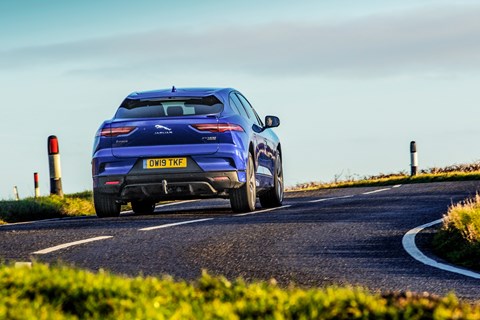
But that performance is for another day: I accelerate steadily up to the speed limit, then adhere resolutely to it. The £1350 Drive pack, with blind-spot monitoring, automated emergency braking and crucially adaptive cruise control is my ally. The stop and go system is not too edgy, taking its time before slowing the car for traffic ahead.
Good job too, because having to pile speed back on is the enemy of range. So I'm keen to carry as much momentum as is prudent into roundabouts and corners, where the i-Pace just feels mighty. Swing the steering wheel, hold the throttle and the tyres just bite, scything the car through the apex, helped by those low-set batteries dropping the centre of gravity. The handling defies the 2.2-tonne heft.
I arrive home. My destination for tonight, but 'the start of a journey' in the parlance of Love Island contestants and clunking sports stars. It's a journey to find my true inner power source (electric or combustion?), overcome adversity and triumph against the odds – or I'll potentially settle for never running out of charge, thank you.
The binnacle says 151 miles, and 58% of the battery, remain. Looks like tomorrow's going to be an office day after all. I think I'm going to absolutely love this car...
By Phil McNamara
Our i-Pace's style details: how we've specced it
Turn on the matrix: £1850
The i-Pace S comes as standard with LED headlights, but you can add 'signature' daytime-running lights for £1100 or upgrade to our matrix LED lights, which selectively dip the light cone so you can maintain full beam without dazzling oncoming traffic. They're £1850, or £950 on the SE.
Two little ducks, 22: £2900
Standard 18-inch wheels help maximise range, but look weedy. We drove the cars on 20-inch wheels at the launch, a good compromise but one that miffed former design boss Ian Callum. This time our car goes full Callum on 22s, a punchy £2900 extra.
Heated, very cool: £3940
The biggest chunk of our £16k option spend goes on heated and cooled 14-way adjustable Performance seats lifted from the F-type. They're firmer than the comfort-focussed standard chairs, but sexier and hold you better.
By Phil McNamara
Logbook: Jaguar i-Pace S
Price £64,995 (£80,980 as tested)
Performance 90kWh battery, two e-motors, 395bhp, 4.8sec 0-62mph, 124mph
Efficiency 2.5 miles per kWh (official), 2.1 miles per kWh (tested), 0g/km CO2
Energy cost 6.4p per mile
Miles this month 1420
Total miles 6775